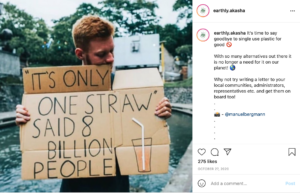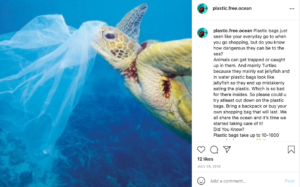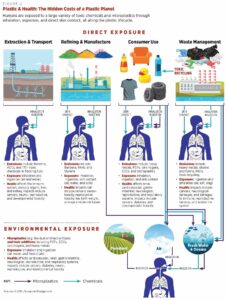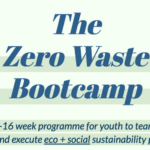Published 21 June 2021 ● Last Updated on 15 June 2022
Plastic is cheap. Plastic is convenient. Plastic is everywhere. It is in the cosmetics that we use, the clothes we wear and even in the food we eat and the water we drink. Plastic has many properties which make it ideal for many applications. It is increasingly difficult to buy things without consuming plastic in some form or the other. Its ubiquitous presence in our world has caused plastic to suffocate our oceans, choke our wildlife and cause unimaginable damage to the environment. There is no denying the revolutionary role of plastic in the medical field- surgical gloves, insulin pens, IV tubes – or the key role that plastic packaging plays in extended the shelf life of food as it travels from farm to table or even the benefits of using plastic parts in cars, rending them lighter and more fuel efficient. The fact is- plastic is not the villain, its overuse is! Here are facts and statistics that we hope will inspire you to live a life with lesser plastic- single use and disposable plastic in particular- and reduce your plastic footprint:
1. Humans vs Plastic: The scale is tied, but not for long!
That people have gone berserk producing plastic due to its myriad uses is not breaking news. What’s alarming is the pace at which it has happened within a short span of time. From the 1950s to the 70s, only a small amount of plastic was produced. However, global production of plastics ballooned from 2 million metric tons in 1950 to 300 million metric tons per year today as per UNEP. The result? Current annual plastic waste we create weighs nearly as much as the entire human population!
What do we do with so much plastic? Presumably we use a large portion – around 40% – for packaging alone ! One would think that cognizant of the environmental impact of plastic there would be grand plans in place for recycling. With a mere 14% of plastic packaging worldwide collected for recycling and only 9% of all plastic waste ever produced being recycled– that seems like a far off reality.
2. The road to hell moon could be paved with plastic waste
In US alone, 50 billion cups end up in landfills every year, reports CNN – enough that if placed end to end, they would go to the moon and back roughly five times! Yes we produce a hell lot of plastic, and we make it worse by producing 50% of it for single-use purposes. Did you know:
- A million plastic bottles are bought every single minute?
- 500 billion disposable cups are consumed every year?
- Roughly 3.5 billion toothbrushes are sold worldwide each year, most of which end up in landfill or as plastic pollution in the natural environment?
- Every day more than a billion plastic straws are used for 20 minutes or less and then tossed in the rubbish bin?
It seems the problem lies with the widely prevalent ‘throwaway’ culture. We don’t think twice before taking a new plastic bag when we go to buy groceries, but would you be more inclined towards giving up disposable plastics if you knew that a plastic bag has an average working life of 15 minutes and it takes 1000 years for a plastic bag to degrade in the fill? If this does not inspire you to take your own bag-plastic or not the next time you go grocery shopping we don’t know what can.

3. There is no throw ‘away’ – Most of the plastic ever created is still around
Is it normal for straws and sea turtles to cohabit the same space? This video will tell you why not. The problem lies not just with the inconceivable amount of plastic waste generated, but also the amount which enters the ocean. Of the 8.3 billion metric tonnes of all the plastic created by 2015 only 9% was recycled, 12% was incinerated, while an enormous 79% accumulated in landfills, dumps or the natural environment– slowly making its way into our oceans. Here’s a fact to ponder over –nearly 11 million metric tons of plastic enter the oceans every year; that’s 3% of global annual plastics waste. That’s like dumping a garbage truck full of plastics into the ocean every minute and straight into the stomach of animals who mistake it for food! According to this article some 700 species of marine animals have been reported so far to have eaten or become entangled in plastic. Unless we take action now, it’s expected that the amount of plastic littering the world’s ocean will triple within a decade and by 2050 there will be more plastic than fish (by weight) in the ocean-another score for plastic!

4. We are eating credit cards without knowing it
You would never willingly eat a plastic cup or a plastic spoon because it tasted good right? But the fact of the matter is a lot of what we eat and drink is contaminated with plastic and goes directly into our system. A study commissioned by WWF calculates that an average person could be ingesting approximately five grams of plastic every week – the equivalent of one credit card! How does this happen? Well did you think that all the plastic which ends up in the landfills, our waterways and ocean would not end up on our plate or in the water we drink? That’s just wishful thinking.
Plastic does not biodegrade and over a period of time breaks down into smaller pieces of plastics called microplastics consumed by us in the form of beauty products we use, sea food we eat and water we drink. A study of tap water found 80% of samples polluted by plastic which roughly translates to an average person consuming 1,769 particles of plastic every week from tap water alone. It’s almost like the loop of plastic which starts with humans and ends inside humans – we use, we throw without care, we ingest.

5. Plastic stinks of greenhouse gases
Plastic pollution is also a much bigger and sinister climate issue. If you really want to know its environmental impact, you have to think back to the beginning of its lifecycle which begins with its main ingredient – fossil fuels. As you would expect, the emissions related to fossil fuels form a big piece of the plastic emission pie. Even recycling and incineration of plastic waste -the supposed panacea to overuse of plastic- are processes which release greenhouse gases.
Microplastics found on ice caps and the resultant effect on glaciers have to be factored in as well when calculating the carbon footprint of plastic. To put it in numbers, research calculates that across their lifecycle, plastics account for 3.8% of global greenhouse gas emissions. In its current form, greenhouse gas emissions from cradle to grave of plastic could reach 56 gigatons, or up to 13% of Earth’s entire remaining carbon budget. If plastic were a nation, it would be the fifth highest carbon emitting country in the world.
Before we go
Many of the plastic facts and statistics stated above are overwhelming and deeply upsetting. While there is a lot of positive action, the truth is that much more needs to be done. Think of the things you can do in your individual capacity to transition to plastic-free living. From choosing eco-friendly alternatives to plastic, to thinking of creative ways to upcycle plastic bags or to carrying your own coffee mugs to work-the lifestyle changes that you can make to solve the plastic problem are endless.
Related links:
Microplastic Mayhem | The tiny pollutant that has a big impact



0 Comments